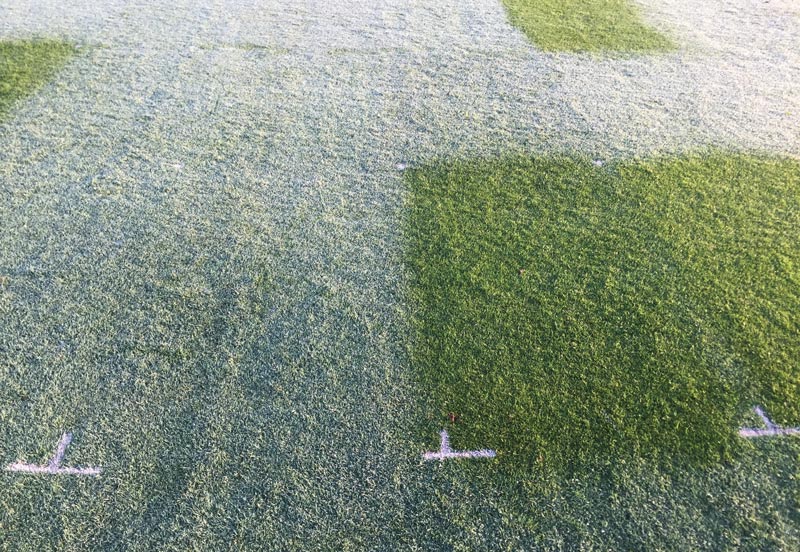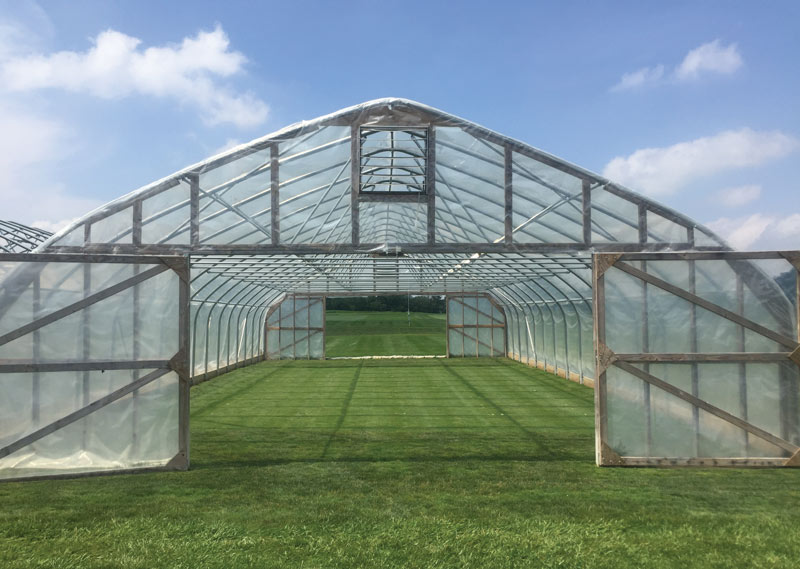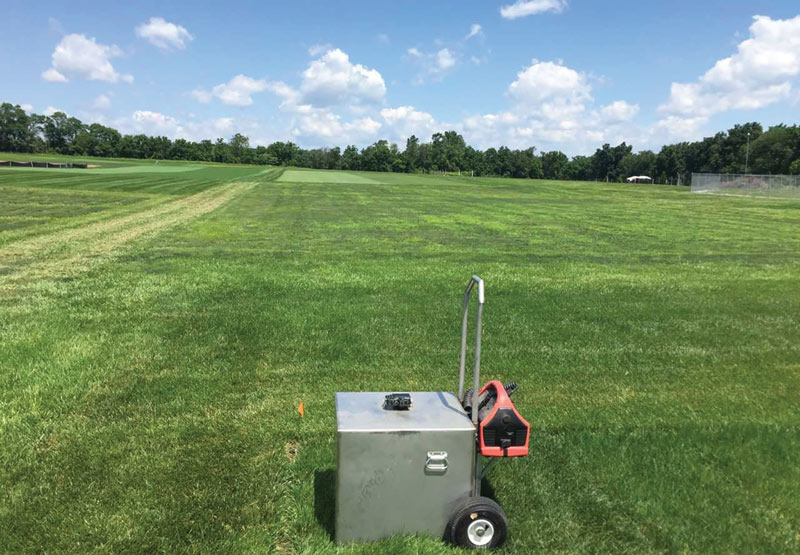
Researchers recorded the presence or absence of dew and leaf wetness on these test plots treated with biostimulant products. This is an example of the kind of observational data required to support biostimulant label use claims. Photos by Mike Fidanza
The so-called miracle products promoted, sold and used in turf management are often referred to as “snake oil” or “foo-foo juice” (a sarcastic reference to the mythical foo-foo tree). Some products make claims that are substantiated with scientific research in turfgrass systems, while many others lack direct evidence that they actually work within a turf management program.
The term “plant biostimulant” is often used to describe the various categories of substances used in these products: plant growth hormones (for example, auxins, abscisic acid, cytokinins, gibberellic acid), microorganisms (for example, Bacillus species, mycorrhizae, etc.), amino acids, humic and fulvic acids, plant defense-inducing substances, plant growth-promoting substances, vitamins, pigments and oils, soil amendments, soil conditioners, composts and compost teas, etc.
The EU’s take on plant biostimulants
Recently, the European Union has proposed policies and regulations to support and enforce what it calls a claims-based definition of plant biostimulants. In other words, plant biostimulant products should be defined by their function, not by the ingredients inside the container.
The EU also proposed that plant biostimulant products should be required to have credible demonstrated effects to support the product claims — that is, documented research to support product label statements for the crops and markets targeted.
For example, if product A contains a microorganism that, when applied to the soil, interacts with plant roots to induce a plant defense response to a plant pathogen, then the manufacturer must provide data supporting that claim for that particular crop and use. No longer would the manufacturer be able to state that “because the microorganism has been shown to induce a plant defense response in peppers, go ahead and use it on putting greens.” The manufacturer would have to prove the biostimulant inside the product performs the function for that particular crop or use as stated on the label.
The European Biostimulant Industry Council (EBIC) has worked in partnership with government, academia and industry to co-develop guidelines for assembling the proper dataset that reflects consistent and reliable trial results. The guidelines contain two main points: Data must be generated to support the biostimulant claim, and that data must be used to place the product into the EU market and/or support commercial product claims. The data required will depend on the biostimulant’s claim.
Defining plant stimulants
The EBIC’s functional definition of plant biostimulants is as follows: “a material which contains substance(s) and/or microorganisms whose function, when applied to plants or the rhizosphere, is to stimulate natural processes to benefit nutrient uptake, nutrient efficiency, tolerance to abiotic stress, and/or crop quality, independently of its nutrient content.”
Why is there a functional definition of plant biostimulants? The EU’s position is that the purpose of biostimulants is to support ecology-based agricultural and food production systems. Take, for example, the last part of the definition: “to stimulate natural processes ... independently of its nutrient content.” Although a biostimulant product may contain a fertilizer component (that is, nitrogen or iron), the observed demonstrated response of the plant is due to the biostimulant and not the fertilizer effect.

A hoop house rainout shelter is used for evaluating the efficacy of biostimulants in alleviating the effects of drought and heat stress.
For example, when plants are subjected to drought and/or heat stress, increases in clipping yield or chlorophyll content could not be achieved by the application of the minute amount of nutrients in the biostimulant product when these nutrients are applied alone as a positive check.
Research-based data
Regarding the required research-based data needed to support biostimulant claims, the EU has proposed guidelines and criteria for laboratory, greenhouse and growth chamber experiments that include the use of a 90% probability statistic and field trials, particularly field trials conducted under real-world conditions. Included in those guidelines are the number of trials (three) required under various environmental and geographic conditions, and the appropriate use of statistical analysis and data interpretation. Published, peer-reviewed scientific literature can be used to support a claim if it is of acceptable quality under those EU guidelines.
Considering biostimulants: Advice for golf course superintendents
Should the U.S. Department of Agriculture adopt the EU’s claims-based definition of biostimulants for use in the United States? If so, what does that mean for our industry? Moreover, what do golf course superintendents think about a claims-based definition of biostimulants?
What are the key questions superintendents should ask when considering a plant biostimulant product?
- What’s in it?
- What is its function? How does the product claim to benefit turf?
- Will the product function in all climates, soil types, turf species and stress conditions?
- Does the product function best to help with abiotic (drought, heat, salt) or biotic (insects, pathogens, traffic) stresses?
- Where’s the data? What does the data show that the product does when the product is applied to turf? Were the effects both qualitative and quantitative in replicated field trials?
- Does the manufacturer have clear data showing that all or most of the product’s ingredients are essential to its function? Does the data show how individual ingredients, when tested against the formulated product, no longer provide the functional benefit?
Currently in the U.S., most biostimulants are sold as components in fertilizer formulations or as soil amendments. Would development of clear definitions and guidelines for biostimulant products benefit the turf industry? Let’s assume a new product appears in the market. A good first question to ask would be whether the product has been appropriately developed.

The photo light box is a necessary tool for properly capturing a digital image of an individual test plot. The image can then be used to quantify turf quality and determine whether biostimulants improve plant health.
First and foremost, look for technical backup. That technical backup begins with the product technical or sell sheet.
- Does it cite field research?
- What turfgrass species was used and for what purpose?
- What were the turf cultural practices?
- What’s the soil type (root zone)?
- What were the climatic conditions?
Biostimulant products are commonly formulated from multiple components and/or are of undefined composition. While activity may be measured from such formulations, is the observed plant or soil response a consequence of a single component or a multiplicity of components? In studies conducted in growth chambers and in the greenhouse, effects of single components can be measured. However, measuring such effects in the field is often more challenging. One or more complex formulations may need to be applied to observe a visual plant response. The challenge then becomes explaining which components were responsible for the observed effects.
Conclusions
Products that contain biostimulants provide management options to maintain turf performance under stress. Moderating stress is a key component to building a healthy, resilient turf stand. As stress builds, a number of plant processes may be compromised: Efficiency of light and carbon capture decline; destructive reactive oxygen species (free radicals) increase in shoots and roots; roots take a double hit because shoots stop allocating energy to roots and may pull energy from roots; and root decline (coupled with pressure from secondary plant pathogens) precedes shoot decline.
Should a biostimulant product become a valuable part of your turf management program? This all depends on what exactly a turf manager wants to accomplish (for example, better rooting, better tolerance of heat or drought stress, traffic tolerance, turf recovery, disease prevention, better color or visual quality, better playability).
Be sure to critically evaluate your turf for the response you want. If you decide to include these products as part of your turf management program, it’s important to make many observations and measurements throughout the year and document what you are seeing so that you can make informed decisions going forward. Also be sure to review all available information and consider that the use of a biostimulant or any product should be predicated on results from independent and replicated third-party research.
The research says ...
- Proposed government regulations in Europe aim to legally define and categorize biostimulants based on how they function and provide a benefit to the plant, and not by the active ingredient on the product label.
- European regulations will require biostimulant products to have a record of credible research to support the product label claims of their performance and function.
- Will the U.S. adopt the European approach and allow only claims-based biostimulant products into the market?
- U.S. turf managers considering a biostimulant should review the research that shows how the product affects turf, and then carefully integrate the biostimulant product into their turf management program and critically evaluate any potential benefit over time.
Literature cited
- Du Jardin, P. 2015. Plant biostimulants: Definition, concept, main categories and regulation. Scientia Horticulturae 196:3-14. doi:10.1016/j.scienta.2015.09.021
- Ricci, M., L. Tilbury, B. Daridon and K. Sukalac. 2019. General principles to justify plant biostimulant claims. Frontiers in Plant Science doi:10.3389/fpls.2019.00494
Mike Fidanza is a professor of plant and soil science, and Stan Kostka is a visiting scholar at the Berks Campus of Penn State University, Reading, Pa.; Erik Ervin is a professor and chairperson of the Department of Plant and Soil Sciences, University of Delaware, Newark, Del.; and Cale Bigelow is a professor of turfgrass science in the Department of Horticulture, Purdue University, West Lafayette, Ind.